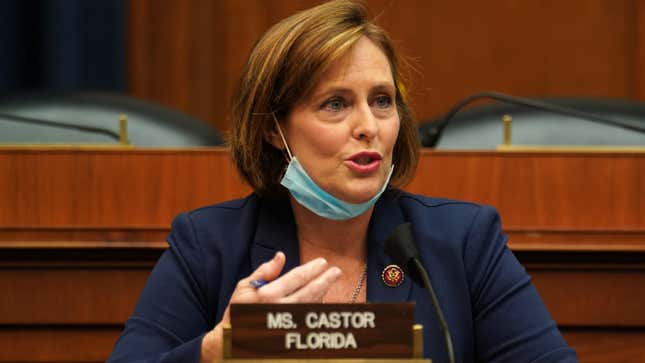
Democrats unveiled a 500-page plan to address the climate crisis on Tuesday morning. Its goals include reaching 100% electric vehicles by 2035, net-zero carbon emissions in the electricity sector by 2040, and in all sectors by 2050. If implemented, it says it would reduce greenhouse gas emissions to 37% below 2010 levels by 2030, and 88% below 2010 levels by 2050.
The plan was written by Democratic majority of the House’s Select Committee on the Climate Crisis. House Speaker Nancy Pelosi created the committee last year as a watered down version of a proposal by Rep. Alexandria Ocasio-Cortez. Its introduction comes more than a year after AOC put forth her resolution on a Green New Deal, which Pelosi infamously dismissed as the “Green Dream or whatever.”
With that backstory in mind, the plan is surprisingly thorough. It draws clear inspiration from many aspects of the Green New Deal championed by the climate movement, including reaching net-zero carbon emissions within 30 years, the creation of “millions of good-paying, high-quality jobs,” and a focus on building equitable transit, housing, and power grids.
“In the past two years since launching the Green New Deal, young people have brought the clarity and urgency of the crisis to Congress, and we are happy to see the Select Committee’s Action Plan reflect much of the vision for a Green New Deal,” Lauren Maunus, Sunrise’s legislative director, told Earther. “That’s a real sign that young people are changing politics in this country and the establishment is scrambling to catch up.”
It also picks up policy ideas from the plan Washington Governor Jay Inslee put forth in his presidential primary run and the roadmap his former staffers laid out as Evergreen Action. Among the Inslee planks are federal incentives to drive state and local building codes toward mandating new zero-emission buildings by 2030, the creation of a Green Bank to finance sustainable projects, and the creation of an equity-based solar initiative in the Department of Energy to promote energy democracy and community-led investment.
“We’ve been working with the Select Committee since days after the Inslee campaign ended,” Jared Leopold, a former senior communications advisor for Inslee and member of Evergreen Action, told Earther in an email. “This is definitely a step in the right direction on strong targets.”
The plan’s focus on eliminating emissions from the three largest sources of greenhouse gas emissions–electricity, transit, and buildings—would also be a big step up for the U.S. if implemented. The proposal aims to reach 100% clean electricity by 2040, 100% zero-emissions car sales by 2035, and 100% renewable-powered new buildings by 2030. Leah Stokes, assistant professor of political science at the University of California, Santa Barbara, told Earther in an email that on these three fronts, “the plan is more ambitious than we have tended to see from Congress. Together, these three sectors account for about 70% of the carbon emissions, so they must be central.”
But though it’s a start, the plan could be even more ambitious, particularly in regard to regulating fossil fuel production. The plan includes regulations and incentives to reduce methane leakage 90% by 2030, which Stokes said “may not be as ambitious as is necessary.” It also aims to eliminate tax breaks for “large” oil and gas companies, but many corporations that frack oil and gas in the U.S. are small. And it calls for the elimination of “unfair and expensive government subsidies for oil and gas drilling on public lands,” but all fossil fuel subsidies should be eliminated to really address the crisis. And the plan does not directly set an end date for oil and gas expansion, which is a problem since the oil and gas projects already in the pipeline globally spell disaster for the climate.
The plan’s targets for phasing out emissions could also be far stronger. It’s true that the United Nations’ Intergovernmental Panel on Climate Change, the world’s top climate body, has shown that global net carbon emissions must reach net-zero by around 2050 to keep heating to 1.5 degrees Celsius (2.7 degrees Fahrenheit). But UN has also said that since the U.S. is the largest historical emitter of greenhouse and current second biggest carbon polluter, the country should bear a particularly heavy burden. As writer and meteorologist Eric Holthaus pointed out on Twitter, to pull its fair share, the U.S. would have to cut its emissions by 72% by the end of the decade.
“The slower we go, the greater the damage,” Peter Kalmus, a climate scientist at NASA’s Jet Propulsion Laboratory told Earther in an email, speaking on his own behalf. “I think there will be a growing consensus over the next few years, as climate-related disasters continue to increase in frequency and intensity, that ‘2050 thinking’ isn’t big enough.”
Of course, the plan—let alone anything even stronger—is unlikely to win majority support in the Republican-controlled Senate. The select committee itself is bipartisan, but the report is only from the Democrats on the committee. Polls show that Democratic voters strongly support urgent action on the climate crisis, and climate action plans could be a good way to drum up support for the party to retake the Senate and White House.
“This plan is more ambitious than anything we have seen from Democratic leadership so far, but it still needs to go further to match the full scale of the crisis,” said Sunrise’s Maunus. “There’s nothing to lose by going bigger. Taking action at the scale of the crisis will help lift our economy out of recession and put millions of people back to work building a more just and resilient society.”